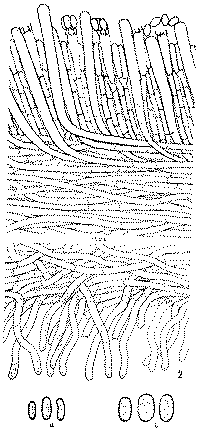|
 Stereum scutellatum Stereum scutellatum
BiostatusPresent in region - Indigenous. Endemic
Images (click to enlarge)
Caption: Pl. 21, fig. 2. Stereum scutellatum, x 2/3. | 
Caption: Fig. 2. Transverse section of Stereum scutellatum, x 500. Showing conducting hyphae,
monomitic hyphal system, surface hairs at the base. [a. Spores of Stereum sanguinolentum, x
1000.] b. Spores of Stereum scutellatum, x 1000 |
Article: Cunningham, G.H. (1956). Thelephoraceae of New Zealand. Part IX. The genus Stereum. Transactions of the Royal Society of New Zealand 84(2): 201-231.
Description: Hymenophore annual. membranous, loosely attached, scattered, becoming coalesced. Pilei
commonly resupinate, or resupinate with raised margins when 1-5 mm radius, at first
orbicular and consisting of numerous small scattered colonies 2-10 mm diameter, coalescing
to form irregularly linear- areas to 12 x 3 cm; pileus surface straw colour, with appressed
fibrils radiately arranged, striate, occasionally zoned with different bands of colour, when
resupinate margins thinning out, fibrillose, 1-3 mm wide, grey or isabelline; hymenial surface
at first cream, with reddish blotches where injured, soon darkening to purplish or plum, not
creviced but showing concentric ridges or angular lines of colour indicating coalesced
margins. Context isabelline or wood colour, 0.1-0.25 mm thick, of parallel compacted
hyphae, with a yellow cortex beneath pileus hairs; hyphal system monomitic; generative
hyphae 3-4 µ diameter, walls 0.5-l µ thick, hyaline, freely septate, somewhat freely branched,
without clamp connexions; scattered lenses of crystals embedded in tissues of the context and
hymenium. Hymenial layer 50-90 µ deep, a dense palisade of basidia, paraphyses and
conducting hyphae. Basidia subclavate, 28-35 x 6-8 µ, 2-4-spored; sterigmata slender,
upright, to 6 µ long. Paraphyses subclavate, shorter and narrower than the basidia.
Conducting hyphae arising in the base of the subhymenium and upper layers of the context,
extending obliquely into the hymenium and projecting to 25 µ, 60-95 x 6-9 µ, filled with
granules and oil globules, fuscus, walls 0.5 µ thick. Spores oblong with rounded ends, 7-10 x
5-6 µ, walls smooth, hyaline, 0.25 µ thick.
Habitat: HABITAT. Loosely attached on bark of dead branches and trunks.
Distribution: DISTRIBUTION. New Zealand.
Notes: Both S. scutellatum and S. sanguinolentum possess monomitic hyphal systems, conspicuous
conducting hyphae, and turn scarlet where cut or bruised on the hymenial surface. S.
scutellatum differs in its scutelliform fructifications, which are commonly resupinate (or, if
pileate, pilei are merely upturned margins), larger spores, broader basidia, and different host
range. The hymenial surface is of different colour, not creviced at any stage, and is marked by
colour lines or raised ridges where colonies have coalesced. The collection from
Dracophyllum differs in several features, the context being thinner, basidia larger (40-56 x
10-12 µ), spores 10-12 x 6-7 µ. Until further collections come to hand, and it can be
ascertained if these features are constant, it has been held under the present species. In
actively growing plants conducting hyphae of S. scutellatum project, as is shown in the
sectional drawing; but as plants age they collapse and are replaced with organs which do not
extend beyond the surface.
|